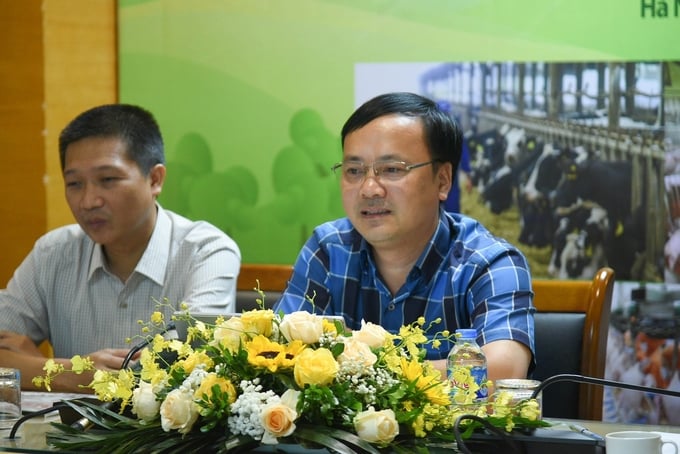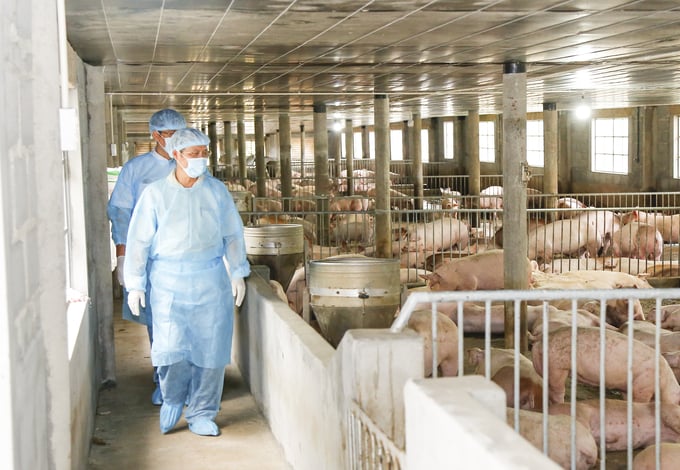June 2, 2025 | 01:38 GMT +7
June 2, 2025 | 01:38 GMT +7
Hotline: 0913.378.918
June 2, 2025 | 01:38 GMT +7
Hotline: 0913.378.918

Phan Quang Minh, Deputy Director of Department of Animal Health (Ministry of Agriculture and Rural Development), said that the whole country currently has over 2,400 facilities and livestock areas certified as disease-free in 57 provinces and cities. Photo: TQ.
The National Agricultural Extension Center (NAEC) recently collaborated with Dan Viet Newspaper and De Heus Vietnam Co., Ltd. to organize a workshop named "Building disease-free livestock areas, promoting processing and export of meat and livestock products". Phan Quang Minh, Deputy Director of the Department of Animal Health (Ministry of Agriculture and Rural Development) gave some information about the livestock industry in the first 6 months of 2023.
Accordingly, all types of diseases in cattle and poultry have shown signs of decrease, and there is no record of foot-and-mouth disease outbreaks in the whole country. Avian influenza outbreaks have been eliminated and there are currently no active outbreaks. As for papular dermatitis, the animal health sector has had some initial success in the research for vaccines.
The Department of Animal Health has coordinated with local authorities and businesses to build 1 disease-free livestock area and 235 disease-free facilities. The district level in particular has 93 disease-free poultry facilities, 130 disease-free pig facilities, and 12 facilities for other livestock.
To sum up, the whole country has more than 2,400 facilities and livestock areas certified to be disease-free in 57 provinces and cities. There is 1 provincial-level livestock area, 38 district-level areas, 228 commune-level areas and nearly 2,200 facilities. Classified by species, there are more than 1,000 disease-free facilities and areas for poultry, more than 1,300 facilities and zones for cattle and 47 rabies-free areas.
Regarding the next steps, the Department of Animal Health will continue to support localities and companies in building disease-free areas for cattle and poultry. The industry's goal is to successfully build disease-free livestock chains in the Southeast region in accordance with Vietnam’s regulations and the standards of the World Organization for Animal Health (WOAH).
“Since 2016, NAEC has developed several pilot models on the construction of disease-free livestock areas for pigs and poultry in 5 provinces of the Southeast region and 3 provinces of the Red River Delta. Through training activities, science and technology transfer, and support in terms of model building, 188 livestock models have been recognized as disease-free with the help of the center,” said Nguyen Van Huong, Deputy Head of the Department of Animal Husbandry and Veterinary Extension (NAEC).
After successfully implementing disease-free livestock models, the Ministry of Agriculture and Rural Development has approved the National Agricultural Extension Center to continue implementing and replicating the disease-free livestock model in 3 Red River Delta provinces and Thanh Hoa.

The National Agricultural Extension Center has received approval from the Ministry of Agriculture and Rural Development to continue implementing and replicating the disease-free livestock model in 3 Red River Delta provinces and 1 Central province, Thanh Hoa. Photo: TQ.
Sharing important solutions to protect livestock against common diseases as well as experience in building a closed livestock chain which aims towards export development, Nguyen Quang Hieu, Director of External Relations (De Heus Vietnam Co., Ltd), emphasized the challenges Vietnam's livestock production is facing, of which the two biggest risks are price and disease.
“Livestock prices fluctuate continuously within the market so we cannot intervene. Risks from diseases mainly come from the caring and management stages. We have tools to put disease outbreaks under control, but if an epidemic occurs, restoring livestock production will be very difficult as it would lead to a great risk of pathogens left in the environment”.
Facing the current situation, De Heus Vietnam has determined to strengthen disease control, considering this a key factor to the success of its livestock investment, with the main focus being the company’s breeding herds. Livestock complexes are scientifically planned to minimize disease transmission from one group of animals to another. De Heus Vietnam also applies modern technology such as automation, using silos in food preservation, reducing plastic packaging, and risk-reduction transportation systems.

Nguyen Quang Hieu, Director of External Relations (De Heus Vietnam Co., Ltd), believes that Vietnam's livestock production is facing two big challenges, which are price and disease. Photo: TQ.
Building a buffer zone around disease-free areas is essential to minimize the risk of pathogens from outside entering the production chain. From now until 2024, De Heus Vietnam will disseminate information in the 10 km buffer zone around the commercial chicken farming facility within the production chain of the company in 7 provinces in the Southeast. The goals are to provide training and guidance for at least 50% of households, establishments, and farms raising chickens in the buffer zone, and carry out periodic monitoring to identify the circulation level of pathogens as per regulations.
Translated by Samuel Pham

(VAN) Several scientists and farmers are experimenting with soil treatment in some key durian-growing regions such as Cai Lay (Tien Giang), Dak Song, Gia Nghia, and Dak R’lap (Dak Nong).
/2025/05/25/4127-3-073637_820.jpg)
(VAN) Thanks to the promotion from an FAO-implemented project, vegetable production in greenhouses in Moc Chau has seen strong development, from 1.5 hectares in 2021 to nearly 50 hectares in 2024.

(VAN) FAO has recently supported USD 140,000 to implement the project 'Risk mitigation human-animal interface risks through disease control initiatives in pig farming.'

(VAN) The People's Committee of Tra Vinh province has approved an adjustment to the investment policy for the Green Hydrogen Plant project, increasing its area to approximately 52.76 hectares.
![Reducing emissions from rice fields: [2] Farmers’ commitment to the soil](https://t.ex-cdn.com/nongnghiepmoitruong.vn/608w/files/news/2025/05/05/dsc08881jpg-nongnghiep-140632.jpg)
(VAN) Clean rice cultivation model in Thuong Tan commune, Bac Tan Uyen district, is assisting local residents in achieving sustainable agriculture by substantially reducing costs, increasing productivity, and protecting the environment.

(VAN) At the conference to disseminate Resolution No. 68, AgriS introduced its digital agricultural ecosystem and reaffirmed its commitment to accompanying the Government in promoting private sector development and sustainable agriculture.

(VAN) 'Blue Ocean - Blue Foods' initiative is designed to restore marine ecosystems and establish sustainable livelihoods for local communities by cultivating a minimum of 1,000 hectares of cottonii seaweed in the first three years.